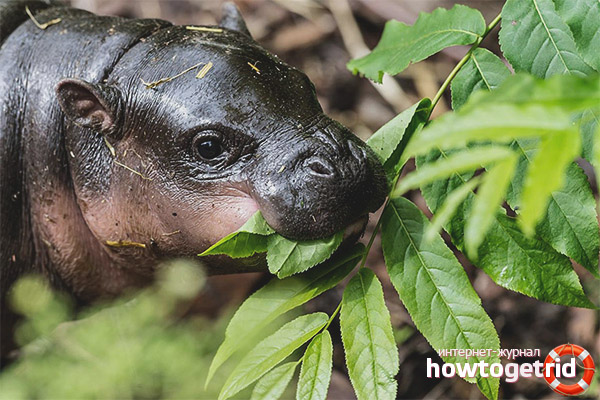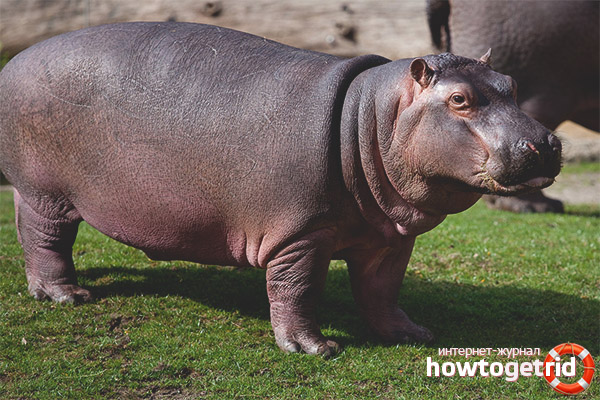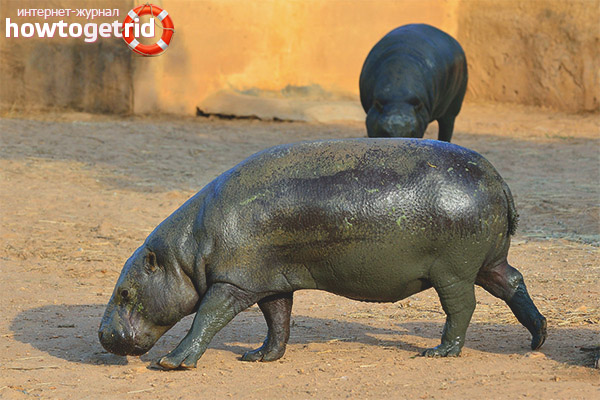The content of the article
Recently it has become fashionable to keep unusual pets at home as pets. If earlier it was limited to dogs, cats, birds and fish in an aquarium, then in the present century the situation has changed. People want to have something unusual in the house, and they buy tigers, snakes, peacocks, ostriches and other original animals. One of these unusual pets is the pygmy hippo.
What is an animal, and what is its difference from a large hippopotamus - this will be discussed. It is worth saying that the lifestyle of the dwarf hippo in natural habitat is poorly studied, most of the knowledge about these animals was obtained by observing them in captivity, where they are mainly kept.
Appearance
The pygmy hippopotamus (Liberian pygmy hippo) is very similar to its large brother, the common hippopotamus. Only smaller, not so impressive, and even less massive. The dimensions of an adult hippo are from one and a half meters to 175 centimeters, height - 75-90 centimeters, weighs 180-280 kilograms. The skin, like that of a large brother, is thick brown or black with a greenish color, on the stomach a little lighter. The tail grows to 20 centimeters.
Comparing the pygmy hippopotamus with the common hippopotamus, you can find a number of the following differences:
- The legs are proportional to each other, the fingers are deployed more strongly, the membranes between them are not so pronounced.
- The head is small, in relation to the body less than that of a standard namesake, eyes with nostrils are shifted closer to the skull. This gives the face an emotion and beauty.
- While large hippos possess two pairs of incisors, the Liberian are content with only one.
- The back is tilted forward slightly to make it easier to overcome dense vegetation.
Where do they live
Dwarf hippos live in the lower part of the African Niger River, there the flow is very calm and unhurried, and the banks are covered with dense tropical thickets. Most of the animals (about 3 thousand individuals) live in Liberia (that's why the name is), a small number lives in the forests of the Congo, Sudan, Cote’d’Ivoire and Sierra Leone.
Habitat and lifestyle
You can meet animals only in forest lowlands near the water - next to swamps, lakes, rivers. These reservoirs serve them as a shelter from enemies and dangers. But for the most part, water is needed to constantly hydrate the skin, so the hippo spends most of the time in water.
Animals show activity after sunset, so that they can be called nocturnal animals. They sleep all day either on the ground or in caves. Repeatedly found in coastal burrows, which it is convenient for them to get directly from the water. Since hippos do not know how to dig holes, they most likely expanded existing ones. The place to relax weekly, and sometimes twice a week, is changing.
Fact! Unlike the ordinary hippopotamus, who does not think of life alone, they prefer to live alone, live in pairs only during mating and raising children.
For each male hippo, there are about two thousand square meters of territory, for females less than about four times - each has 500 square meters. But since they are not territorial animals, they don’t pay attention to the other male who wandered into the boundaries of the plot — they don’t have a showdown trying to prove their sole right to dispose of the territory and stay on it. They just pretend not to notice the stranger.
Hippos avoid open, well visible and not covered with thickets places. On land they travel in tunnels formed by plants.
Breeding
It is difficult to talk about how dwarf hippos breed in natural conditions, since there is no data, and information about this is almost absent. It is not known when the mating season begins under natural conditions, but it can be in captivity in any season, regardless of the time of year. We can only say that they mate both in water and on land. Mating occurs during estrus, lasting a day or two. Usually mate up to four times.
Pregnancy does not last any strictly defined period, stretches from 184 days to 210 days. Delivery takes place most often on land, but sometimes in water. Only children born in depth often drown. One well-developed child is born, twins are quite rare. The weight of the cubs ranges from 3.5 to 6.5 kilograms. Boys born are usually slightly larger. Mother pulls children ashore and breastfeeds. Breastfeeding lasts up to eight months of age. But, besides this, the mother searches for food, returning three times a day to the children and feeding them.
Nutrition

Dwarf hippos love to eat and do this 6 hours a day. And all because herbivorous food contains few calories, and it takes a lot of them to saturate the body. Having slept in the afternoon, with the advent of dusk, animals begin to seek food, and they seek and produce it not only in reservoirs, but also on the shore. Their four-chamber stomachs are adapted only for digesting plant foods, so the diet is entirely vegetarian. With their strong, firm lips, they pull grass, fern, and other plants out of the ground, pick up fallen fruits, and eat shrubs. Dwarf hippos are referred to as pseudo-ruminants.
Enemies
The main natural enemies are leopards. Crocodiles and hieroglyphic pythons also hunt dwarf hippos.
The content of the pygmy hippo at home
Those who wish to have such a hippopotamus at home as a pet will not have much difficulty in terms of maintaining and caring for it. But some nuances should be taken into account, namely:
- A place. Having decided to buy a dwarf hippopotamus, you need to equip him with a site for convenient living. Since he needs to moisten his skin all the time, it is necessary to arrange a pool or small rates. All free time the animal will be next to the water.
- Home. It would be worthwhile to install a fenced aviary on the site, where the animal can walk. Hippos constantly mark the area with caustic and foul-smelling secretions, so you will have to clean several times a day.
- It is necessary to provide the hippo with the usual temperature regime, it is difficult, but you can try by installing a heating system in the aviary.
- Relations with other animals. Liberian hippos are quite peaceful and not aggressive, so there are no problems.
- Behavior. The little hippo is friendly and not malignant, but he is still a wild beast, and can damage the owner with sharp fangs. To avoid this, it is better to keep your distance when communicating with him.
Security
Liberian hippos are classified as endangered. This is due to hunting for them, deforestation and expansion of agricultural land, as well as in connection with frequent civil wars and conflicts in the habitats. The species is listed in the Red Book and is bred in specially created reserves and zoos.
Video: pygmy hippopotamus (Hexaprotodon liberiensis)











Submit